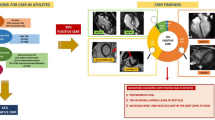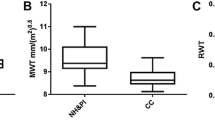Abstract
Purpose
Left ventricular (LV) trabeculation may be more pronounced in ethnic African than in Caucasian (European) athletes, leading to possible incorrect diagnosis of left ventricular non-compaction cardiomyopathy (LVNC). This study investigates ethnic differences in LV hypertrabeculation amongst elite athletes with cardiac magnetic resonance (CMR) and electrocardiography (ECG).
Methods
38 elite male football (soccer) players (mean age 23.0, range 19–34 years, 28/38 European, 10/38 African) underwent CMR and ECG. Hypertrabeculation was assessed using the ratio of non-compacted to compacted myocardium (NC/C ratio) on long-axis and short-axis segments. ECGs were systematically rated.
Results
No significant differences were seen in ventricular volumes, wall mass or E/A ratio, whereas biventricular ejection fraction (EF) was significantly lower in African athletes (European/African athletes LVEF 55/50 %, p = 0.02; RVEF 51/48 %, p = 0.05). Average NC/C ratio was greater in African athletes but only significantly at mid-ventricular level (European/African athletes: apical 0.91/1.00, p = 0.65; mid-ventricular 0.89/1.45, p < 0.05; basal 0.40/0.46, p = 0.67). ECG readings demonstrated no significant group differences, and no correlation between ECG anomalies and hypertrabeculation.
Conclusions
A greater degree of LV hypertrabeculation is seen in healthy African athletes, combined with biventricular EF reduction at rest. Recognition of this phenomenon is necessary to avoid misdiagnosis of LVNC.



Similar content being viewed by others
References
Rawlins J, Carre F, Kervio G, et al. Ethnic differences in physiological cardiac adaptation to intense physical exercise in highly trained female athletes. Circulation. 2010;121(9):1078–85.
Crouse SF, Meade T, Hansen BE, et al. Electrocardiograms of collegiate football athletes. Clin Cardiol. 2009;32(1):37–42.
Magalski A, Maron BJ, Main ML, et al. Relation of race to electrocardiographic patterns in elite American football players. J Am Coll Cardiol. 2008;51(23):2250–5.
Schmied C, Zerguini Y, Junge A, et al. Cardiac findings in the precompetition medical assessment of football players participating in the 2009 African Under-17 Championships in Algeria. Br J Sports Med. 2009;43(9):716–21.
Lewis JF. Considerations for racial differences in the athlete’s heart. Cardiol Clin. 1992;10(2):329–33.
Basavarajaiah S, Boraita A, Whyte G, et al. Ethnic differences in left ventricular remodeling in highly-trained athletes relevance to differentiating physiologic left ventricular hypertrophy from hypertrophic cardiomyopathy. J Am Coll Cardiol. 2008;51(23):2256–62.
Stollberger C, Finsterer J. A diagnostic dilemma in non-compaction, resulting in near expulsion from the Football World Cup. Eur J Echocardiogr. 2011;12(2):E8.
Maron BJ, Carney KP, Lever HM, et al. Relationship of race to sudden cardiac death in competitive athletes with hypertrophic cardiomyopathy. J Am Coll Cardiol. 2003;41(6):974–80.
Kohli SK, Pantazis AA, Shah JS, et al. Diagnosis of left-ventricular non-compaction in patients with left-ventricular systolic dysfunction: time for a reappraisal of diagnostic criteria? Eur Heart J. 2008;29(1):89–95.
Chandra N, Papadakis M, Duschl J, et al. Abstract 17865: hypertrabeculation of the left ventricular apex in elite athletes: pathology versus physiology? Circulation. 2010;122(21_MeetingAbstracts):A17865.
Sarma RJ, Chana A, Elkayam U. Left ventricular noncompaction. Prog Cardiovasc Dis. 2010;52(4):264–73.
Engberding R, Stollberger C, Ong P, et al. Isolated non-compaction cardiomyopathy. Dtsch Arztebl Int. 2010;107(12):206–13.
Jenni R, Oechslin EN, van der Loo B. Isolated ventricular non-compaction of the myocardium in adults. Heart. 2007;93(1):11–5.
Petersen SE, Selvanayagam JB, Wiesmann F, et al. Left ventricular non-compaction: insights from cardiovascular magnetic resonance imaging. J Am Coll Cardiol. 2005;46(1):101–5.
Prakken NH, Velthuis BK, Teske AJ, et al. Cardiac MRI reference values for athletes and nonathletes corrected for body surface area, training hours/week and sex. Eur J Cardiovasc Prev Rehabil. 2010;17(2):198–203.
Pluim BM, Zwinderman AH, van der Laarse A, et al. The athlete’s heart. A meta-analysis of cardiac structure and function. Circulation. 2000;101(3):336–44.
Prakken NH, Velthuis BK, Cramer MJ, et al. Advances in cardiac imaging: the role of magnetic resonance imaging and computed tomography in identifying athletes at risk. Br J Sports Med. 2009;43(9):677–84.
Prakken NH, Velthuis BK, Vonken EJ, et al. Cardiac MRI: standardized right and left ventricular quantification by briefly coaching inexperienced personnel. Open Magn Reson J. 2008;1:104–11.
Nagueh SF, Appleton CP, Gillebert TC, et al. Recommendations for the evaluation of left ventricular diastolic function by echocardiography. Eur J Echocardiogr. 2009;10(2):165–93.
Corrado D, Pelliccia A, Heidbuchel H, et al. Recommendations for interpretation of 12-lead electrocardiogram in the athlete. Eur Heart J. 2010;31(2):243–59.
Du Bois D, Du Bois EF. A formula to estimate the approximate surface area if height and weight be known. 1916. Nutrition. 1989;5(5):303–11. discussion 12-3.
Shrout PE, Fleiss JL. Intraclass correlations: uses in assessing rater reliability. Psychol Bull. 1979;86(2):420–8.
Maron BJ, Gardin JM, Flack JM, et al. Prevalence of hypertrophic cardiomyopathy in a general population of young adults. Echocardiographic analysis of 4111 subjects in the CARDIA Study. Coronary Artery Risk Development in (Young) adults. Circulation. 1995;92(4):785–9.
Oechslin E, Jenni R. Left ventricular non-compaction revisited: a distinct phenotype with genetic heterogeneity? Eur Heart J. 2011;32(12):1446–56.
Alhabshan F, Smallhorn JF, Golding F, et al. Extent of myocardial non-compaction: comparison between MRI and echocardiographic evaluation. Pediatr Radiol. 2005;35(11):1147–51.
Fazio G, Novo G, D'Angelo L, et al. Magnetic resonance in isolated noncompaction of the ventricular myocardium. Int J Cardiol. 2010;140(3):367–9.
Jenni R, Oechslin E, Schneider J, et al. Echocardiographic and pathoanatomical characteristics of isolated left ventricular non-compaction: a step towards classification as a distinct cardiomyopathy. Heart. 2001;86(6):666–71.
Sedmera D, Pexieder T, Vuillemin M, et al. Developmental patterning of the myocardium. Anat Rec. 2000;258(4):319–37.
Papadakis M, Carre F, Kervio G, et al. The prevalence, distribution, and clinical outcomes of electrocardiographic repolarization patterns in male athletes of African/Afro-Caribbean origin. Eur Heart J. 2011 May 25.
Zaidi A, Sharma S. The athlete’s heart. Br J Hosp Med (Lond). 2011;72(5):275–81.
Author information
Authors and Affiliations
Corresponding author
Rights and permissions
About this article
Cite this article
Luijkx, T., Cramer, M.J., Zaidi, A. et al. Ethnic differences in ventricular hypertrabeculation on cardiac MRI in elite football players. Neth Heart J 20, 389–395 (2012). https://doi.org/10.1007/s12471-012-0305-7
Published:
Issue Date:
DOI: https://doi.org/10.1007/s12471-012-0305-7




